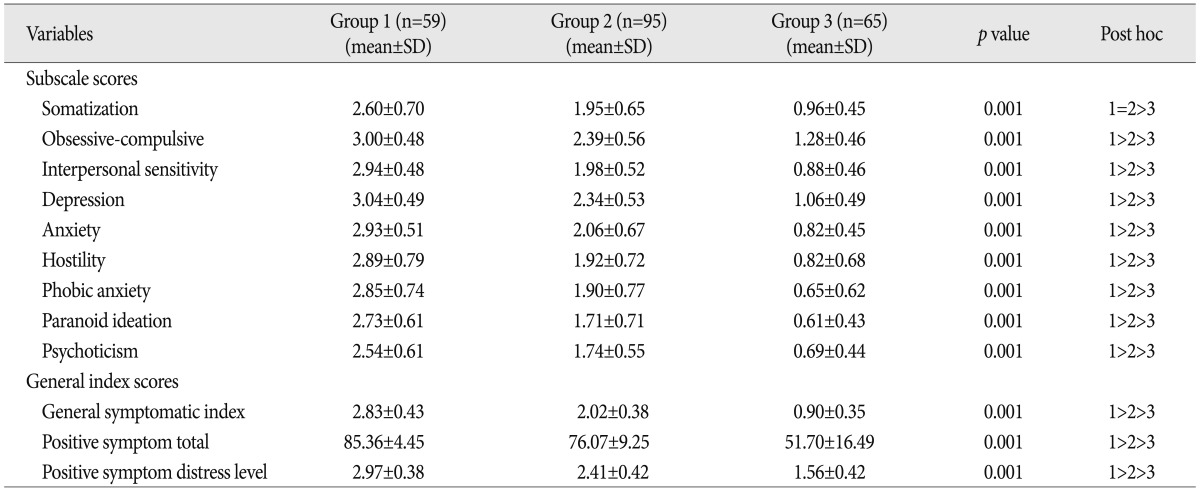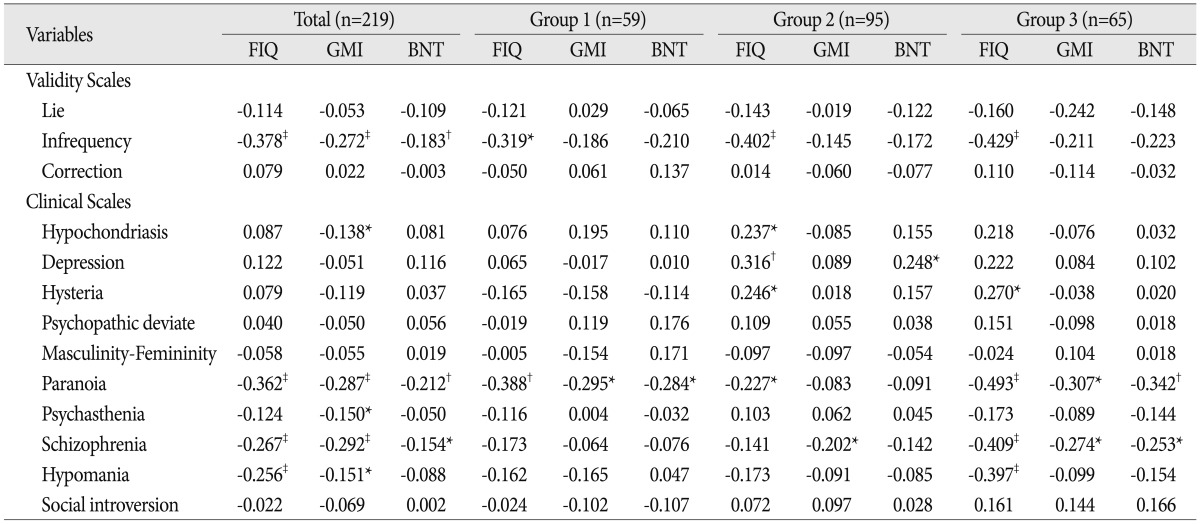1. Arciniegas DB, Anderson CA, Topkoff J, McAllister TW. Mild traumatic brain injury : a neuropsychiatric approach to diagnosis, evaluation, and treatment. Neuropsychiatr Dis Treat. 2005; 1:311–327. PMID:
18568112.
2. Borod JC, Goodglass H, Kaplan E. Normative data on the Boston Diagnostic Aphasia Examination, Parietal Lobe and the Boston Naming Test. J Clin Neuropsychol. 1980; 2:209–215.

3. Bryant RA, O'Donnell ML, Creamer M, McFarlane AC, Clark CR, Silove D. The psychiatric sequelae of traumatic injury. Am J Psychiatry. 2010; 167:312–320. PMID:
20048022.

4. Derogatis LR, Lipman RS, Covi L. SCL-90 : an outpatient psychiatric rating scale--preliminary report. Psychopharmacol Bull. 1973; 9:13–28. PMID:
4682398.
5. Jeon IC, Kim OL, Kim MS, Kim SH, Chang CH, Bai DS. The effect of premorbid demographic factors on the recovery of neurocognitive function in traumatic brain injury patients. J Korean Neurosurg Soc. 2008; 44:295–302. PMID:
19119465.

6. Kay T, Harrington DE, Adams R, Anderson T, Berrol S, Cicerone K, et al. Definition of mild traumatic brain injury. J Head Trauma Rehabil. 1993; 8:86–87.

7. Kim GI, Kim JH, Won HT. Symptom Checklist-90-Revised. Seoul: Jungangjeokseong Press;1984.
8. Kim HH, Na DR. The Korean version Boston Naming Test. Seoul: Hakjisa;1997.
9. Kim YH, Kim JH, Kim JS, Rho ML, Yeon TH, Oh SW. The Korean version Minnesota Multiphasic Personality Inventory. Seoul: Korean Guidance;1989.
10. Lee HS, Park BG, Ahn CI, Kim MLH, Jeung IG. Korean version of memory assessment scales. Seoul: Korean Guidance;2001.
11. Levin HS. Memory deficit after closed head injury. J Clin Exp Neuropsychol. 1990; 12:129–153. PMID:
2406280.
12. Lezak MD, Howieson DB, Loring DW, Hannay HJ, Fisher JS. Neuropsychological assessment. ed 4. New York: Oxford University Press;2004. p. 157–285.
13. Mittenberg W, Aguila-Puentes G, Patton C, Canyock EM, Heilbronner RL. Neuropsychologcial profiling of symptom exaggeration and malingering. In : Hom J, Denney RL, editors. Detection of response bias in forensic neuropsychology. New York: The Haworth Medical Press;2002. p. 227–240.
14. Mittenberg W, DiGiulio DV, Perrin S, Bass AE. Symptoms following mild head injury : expectation as aetiology. J Neurol Neurosurg Psychiatry. 1992; 55:200–204. PMID:
1564481.
15. NoruŠis MJ. IBM SPSS Statistics 19 Guide to Data Analysis. New Jersey: Pearson Education;2011. p. 361–391.
16. Patch PC, Hartlage LC. Behavioral change following traumatic brain injury. In : Horton MN, Hartlage LC, editors. Handbook of forensic neuropsychology. New York: Springer Publishing Company, Inc.;2003. p. 215–235.
17. Rapaport D, Gill MM, Schafer R. Diagnostic Psychological Testing. New York: International University Press;1968. p. 1–562.
18. Rees PM. Contemporary issues in mild traumatic brain injury. Arch Phys Med Rehabil. 2003; 84:1885–1894. PMID:
14669199.
19. Rogers JM, Read CA. Psychiatric comorbidity following traumatic brain injury. Brain Inj. 2007; 21:1321–1333. PMID:
18066935.

20. Ruff RM, Camenzuli L, Mueller J. Miserable minority : emotional risk factors that influence the outcome of a mild traumatic brain injury. Brain Inj. 1996; 10:551–565. PMID:
8836512.
21. Ruff RM, Richardson AM. Mild traumatic brain injury. In : Sweet JJ, editor. Forensic Neuropsychology : Fundamentals and Practice. New York: Psychology Press;2005. p. 315–337.
22. Shin TH, Gong CB, Kim MS, Kim JS, Bai DS, Kim OL. Development of a cognitive level explanation model in brain injury : comparisons between disability and non-disability evaluation groups. J Korean Neurosurg Soc. 2010; 48:506–517. PMID:
21430977.

23. Slick DJ, Sherman EM, Iverson GL. Diagnostic criteria for malingered neurocognitive dysfunction : proposed standards for clinical practice and research. Clin Neuropsychol. 1999; 13:545–561. PMID:
10806468.

24. Teasdale G, Jennett B. Assessment of coma and impaired consciousness. A practical scale. Lancet. 1974; 2:81–84. PMID:
4136544.
25. Wechsler D. Wechsler adult intelligence scale-revised. New York: The Psychological Corporation;1981.
26. Wilson BA, Vizor A, Bryant T. Predicting severity of cognitive impairment after severe head injury. Brain Inj. 1991; 5:189–197. PMID:
1873604.

27. Williams WH, Potter S, Ryland H. Mild traumatic brain injury and Postconcussion Syndrome : a neuropsychological perspective. J Neurol Neurosurg Psychiatry. 2010; 81:1116–1122. PMID:
20802217.

28. Yeom TH, Park YS, Oh KJ, Lee YH. Korean version Wechsler adult intelligence scale. Seoul: Korean Guidance;1992.











 PDF
PDF ePub
ePub Citation
Citation Print
Print




 XML Download
XML Download